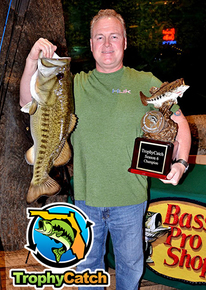
The big TrophyCatch events following the end of Season 6 were the Phoenix Boats TrophyCatch bass boat drawing and Hall of Fame ceremony! Benjamin Porter was the Season 6 boat winner. The Hall of Fame (HOF) ceremony recognized 8 HOF Club catches that weighed 13 pounds or larger, and was held at partner Bass Pro Shops Orlando. Each participant received a life-like replica mount of their trophy from New Wave Taxidermy. Michael Donohue (in photo) submitted the heaviest bass, weighing 15 lbs. 11 oz, which made him the Season 6 Champion and earned him the TrophyCatch Champion trophy! Mark Lemieux landed two HOF bass this season, which also helped land him the TrophyCatch Big Bag Prize for the highest total weight of his top 5 submissions! That prize included a two-night stay at the beautiful Mission Inn Resort and an amazing day fishing with Lake Big Bass Professional Angler and FLW Tour Champion, Tim Fredericks. During his prize trip, Mark landed another TrophyCatch bass weighing 8 lbs. 6 oz. on Lake Griffin (see the Featured Locale below).
The TrophyCatch program is now halfway through its seventh season! Current numbers include:
- 26,969 registrants
- 8,448 approved trophy bass submissions
- 60 documented Hall of Fame size bass 13 pounds or larger
|

The goals of the TrophyCatch program are to:
- Collect valid information through citizen-science about trophy bass to help the FWC better enhance, conserve, and promote trophy bass fishing
- Encourage catch-and-release of the biggest, oldest, most valuable bass
- Excite anglers about Florida freshwater fishing resulting in benefits to anglers, fishing-related businesses, local communities, and the fisheries by having more support and funding for conservation
- Share information about fishing opportunities and destinations to make fishing more enjoyable
You can show your support for bass conservation just by registering for TrophyCatch, which will also automatically enter you into a free drawing for a Phoenix bass boat, and you don't have to submit a fish to win. Check the TrophyCatch website for submission guidelines and prizing.
|
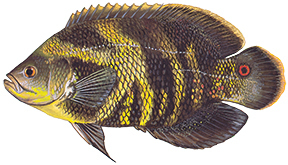
Size: The state record is 2.34 pounds. The Big Catch minimum qualifying sizes are 1.25 pounds or 11 inches for adults, and 0.75 pounds or 8 inches for youth (BigCatchFlorida.com).
Identification and similar species: A dark fish, the oscar is black with variable olive to red markings on most of the body. The key identification aid is the bright red eyespot at the base of the tail. Oscars have a stout, more oval body shape than native bream and a thick mucus coat on the body. Young fish have wavy white and orange markings on a black background.
|

Angling qualities: Oscars provide hard-fighting, panfish-type fishing and are a perfect spring or summer target. The oscar strikes a variety of baits including crickets, live worms, Missouri minnows, and grass shrimp. The best artificial baits include small jigs tipped with cut bait and small spinnerbaits or Beetle Spins; fly fishing with a variety of sinking flies is also productive. Oscars provide a boom-or-bust fishery since they may periodically experience winter kills. But when abundant, angler catch rates are exceptional. There are no bag or size limits for this nonnative species. The white, flaky meat has good flavor.
Where to catch them: Most abundant in canals of the Everglades Water Conservation Areas of Collier, western Miami-Dade, Broward, and Palm Beach counties, where this species ranks second in popularity only to largemouth bass. Occurs throughout south Florida, but typically not as abundant as in marsh-related canals.
Interesting facts: The native range of this exotic includes the Orinoco, La Plata, and Amazon river basins in South America. The oscar was one of first exotic fishes reported in Florida in the late 1950s. The female typically lays about 3,000 eggs and both parents can occasionally be seen guarding hundreds of young in shallow water along shorelines.
Fish illustration by Duane Raver, Jr.
|

“The more things change, the more they stay the same!” This can be true of both life and fishing, and a good example is line. When braided Dacron was introduced around 1950, it was a modern marvel and a big step up from previous silk and cotton lines. Although monofilament was introduced only a few years later, early products were too springy and stiff. Not until better refined monofilaments like Stren hit the market did anglers switch en masse to mono. It was thinner, more abrasion-resistant, maintenance-free, had better knot strength — and was almost invisible. Mono ruled the roost until the 1990’s, when advanced braids like Spiderwire made from super-fibers such as Dyneema, Kevlar, and Spectra hit the market . . . bringing fishing lines full circle back to braid!
|
Braided line is much thinner than monofilament, offering improved line handling and spool capacity.
The biggest advantage of modern braids is their small diameter compared to monofilament lines. For example, 20-pound braid has the diameter of only 6-pound-test monofilament. This offers the best of both worlds with amazing strength, plus the smooth handling, higher line capacity, and longer casts of a much lighter line.

If you are a new braid user, however, you have a few new tricks to learn. First of all, super-slick braided lines will slip on the shaft of the spool. To prevent this, try putting a small backing layer of monofilament on the reel first, then tying and spooling on the braid. Some manufacturers even include foam tape with their lines to serve as spool backing. Loosely wound braid on a spool can dig down into itself and bind, so when you spool up apply more line tension than you may be used to.
You also can’t use braid on cheap or older rods with chrome-plated wire guides. Most modern ceramic or metal guides will handle braid without grooving. But, if you’re thinking of using braid on an old rod or one pulled from the bargain barrel, be aware of this potential problem. Check the tip-top guide in particular. If your braided line is breaking unexpectedly, this might be another sign that it is grooving your guides — which are abrading and cutting the line in return. If this happens, it’s probably time for a new rod. The same applies to older spinning reels, too. Modern reels with roller guides will handle braid, but your old spinner with a fixed, chrome-plated line roller might start grooving. Watch for this and if you see grooving, it’s time for a new reel.
|
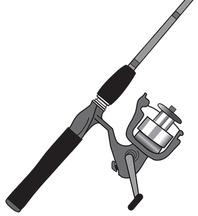
Another fact to keep in mind is that even though that braided line might be the diameter of 6 pound test, it’s actually 20-pound test. So it might cast just fine on a light rod and reel designed for 6-pound monofilament, but neither of those components may be able to handle 20 pounds of strain if you have the drag cranked all the way down and hook a large fish. You can break a rod or warp a reel spool if you don’t select and use a rod and reel rated for braided line. This is more of a factor with older gear, but even with a modern outfit be sure to check the maximum recommended line test.
One of the few potential disadvantages of braid is how limp it is. While this is a plus when casting, the line can wrap your rod tip or tangle much more easily than mono. If you do get a tangle, braid also welds itself into a permanent knot much more readily than mono. Braided lines cost more than monofilament, and you don’t want to discard 30 feet of good line because you can’t untie a knot that develops that far back on the spool. Be careful not to accidentally pull a tangle tight when you get one. While somewhat stiffer braids are available, many anglers prefer the silky-smooth way that limp braid handles.
Despite this limpness, an advantage of braid in most situations is the fact that it has almost no stretch. Monofilament is quite stretchy, evident to any angler who’s ever had to break a mono line off a solid object such as a submerged stump. Braid, on the other hand, is tight as a wire — excellent for strike detection, and for solid hook-setting through thick Texas-rigged plastics into tough fish mouths. Most anglers will probably notice a nice improvement in their hookup ratio when they try braid.
So if your fishing line hasn’t come “full circle” yet, there are lots of reasons to give braid a try! The next issue will cover more braid topics, including knots.
|
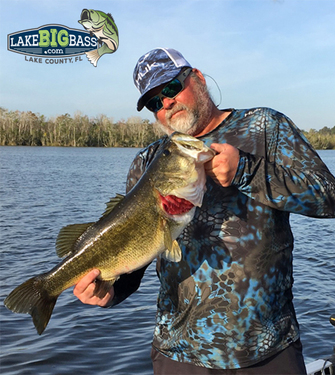
Size: 9,327 acres.
Location: Lake County.
Description: Lake Griffin is the third largest lake in the Harris Chain, located in Lake County, Florida. Lake Griffin has benefited from fisheries and habitat management such as reconnecting Emeralda Marsh, installing fish attractors, bass stocking, and planting aquatic vegetation. The vegetation expansion, along with fisheries and habitat management, has resulted in Lake Griffin being one of the top bass fishing lakes on the Harris Chain. Recently, the Harris Chain of Lakes has become one of the top bass fishing destinations in the nation attracting big-name tournaments (e.g. B.A.S.S., FLW, and Bass Pro Shops: Big Bass Tour) and anglers from all over the world. Many of those tournament anglers spend the extra effort to lock into Lake Griffin and the connecting marshes.
Based on results from recent electrofishing and angler surveys, the largemouth bass fishery is the best it has been in over 50 years. In fact, over the past three years anglers are experiencing excellent catch rates of 0.80 fish/hour, which is the highest ever recorded.
The submersed vegetation on the north end and the recently connected marshes are popular areas to target good numbers and size of largemouth bass. Also, Lake Griffin has numerous residential canals that are popular during the spawning months. Flipping or pitching soft plastics (straight worms or creature baits) is a popular tactic to entice Lake Griffin lunkers. Also, blade jigs, swim jigs, and lipless crankbaits in and around the submerged vegetation can provide excellent fish opportunities.
There are three public boat ramps on Lake Griffin: 1 - Lake Griffin State Park (3089 US highway 441/27 Fruitland Park, FL); 2 - Herlong Park (700 East North Boulevard Leesburg, FL); and 3 - the newly opened Emeralda Marsh Area 3 Boat ramp (Emeralda Marsh Road Leesburg, FL). For more information about Lake Griffin visit FWC's Bass Top Spots.
TrophyCatch partner Lake County Florida Tourism and Lake Big Bass support Florida bass conservation by providing our annual Big Bag Prize (see TrophyCatch Prizing for details).
|
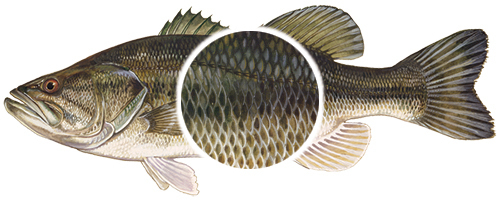 |
Scales are one of the things that define fish.
To biologists, scales are one of a fish’s most distinctive features. Scales come in a wide variety of shapes and sizes, provide protection, and may even be useful for telling what kind of fish you’re holding and how old it is!

There are several kinds of scales. Ganoid scales are heavy and bony, and are found on well-armored fish, such as gar.
Most familiar fish, however, possess two other kinds of lighter but nevertheless durable scales. Cycloid scales (say “SY-cloyd”) are found in trout and some minnows, and possess a smooth margin.
Ctenoid scales (say “TEE-noid”) are found in most other fishes including bass, sunfish, and cichlids, and have a rough margin. For this reason, a freshwater trout feels smoother than a largemouth bass. Some fish, such as catfish, may have either reduced scales or no scales at all, and will feel even smoother to the touch.
|
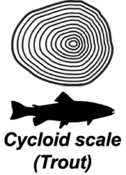
As fish grow, their “coat of armor” must also increase in size. This is accomplished, not by increasing the number of scales, but by growth of the existing scales. A fish will therefore have approximately the same number of scales throughout its entire life! Since the number of scales does not change, certain scale counts (such as the number of scales along the lateral line) can be very useful for telling one kind of fish apart from another. This is a more advanced technique than most anglers will ever need, but they might note the mention of scale counts in some of their more detailed fish identification books.
|

Similarly, since scales grow along with the fish, they can sometimes be helpful for telling how old fish are. Growth rings (similar to those seen in trees) are laid down on scales as they increase in size. Unfortunately, reliably aging fish utilizing scales is not a universal technique. The method works best in areas with markedly different summer and winter temperatures, varies in reliability from one species of fish to the next, and is most dependable with scales taken from only certain areas on a fish’s body — the location of which also varies from species to species! This method does not work well for fishes in Florida, due to our milder year-round climate, and otoliths must be used instead (see The Florida Freshwater Angler Issue 2). However, in more northern climates and for certain species, aging fish using scales is both fast and convenient for icthyologists and is harmless to the fish.
So, take a closer look next time you scale a fish for the frying pan!
Largemouth bass illustration modified from Duane Raver, Jr.
|
To contact the Florida Freshwater Angler, email John Cimbaro.
|